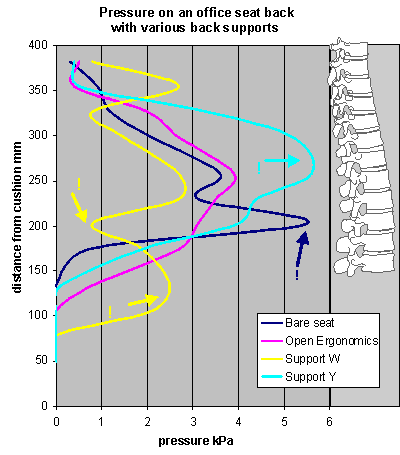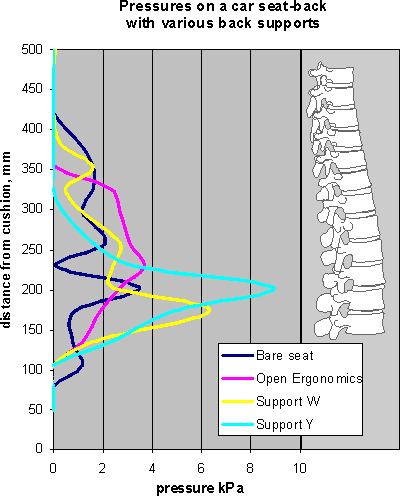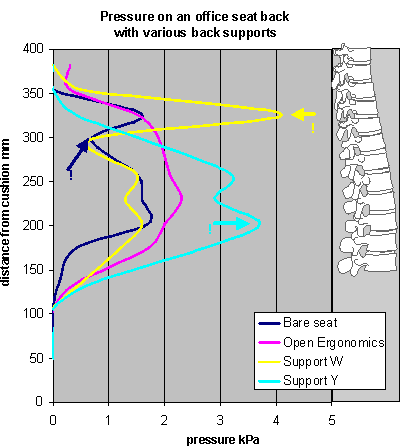|
|
|
This
page is about pressure between you and your seat-back. Because
it is pressure on the skin
which actually supports the body, we can analyse the support by
measuring the pressure.
The
charts below show pressures measured behind people's backs, both
directly on a standard office chair and also using three different
back supports.
|
Notes:
 The
pressures shown are the maximum recorded at each of 12 heights
above the cushion, for one individual. The
pressures shown are the maximum recorded at each of 12 heights
above the cushion, for one individual.
 Because this seat has a gap between back and base, pressure
at the bottom is zero.
Because this seat has a gap between back and base, pressure
at the bottom is zero.
 Ideally, pressure should rise gradually to a peak
at the mid-point of the lumbar curve - around 220-280 mm
from the base cushion depending on the individual, then
taper off again.
Ideally, pressure should rise gradually to a peak
at the mid-point of the lumbar curve - around 220-280 mm
from the base cushion depending on the individual, then
taper off again.  Low pressure behind the pelvis is desirable to avoid
the problem of the pelvis' being pushed forwards along the
cushion.
Low pressure behind the pelvis is desirable to avoid
the problem of the pelvis' being pushed forwards along the
cushion.
 Low pressure behind the upper back is needed to prevent
the shoulders' being pushed forward into a banana shape.
Low pressure behind the upper back is needed to prevent
the shoulders' being pushed forward into a banana shape.
|
|
 This
was a female occupant. This
was a female occupant.
- The
bare seat provided
too little support for the lumbar region (220-280 mm),
giving
peaks at the top of the pelvis and at the shoulder blades.
This pressure distribution will allow the lower spine to
flatten into an unhealthy shape, while the peak at shoulder
level will tend to destabilise the torso and bend it into
an unhealthy banana shape.
- The
Open Ergonomics support
provided a suitable level of support, peaking at the mid-point
of the lumbar curve and easing progressively above and below.
There were no unwanted pressure points and support was consistent.
-
Support W is too flat
in profile, so that it does not follow the preferred lumbar
curve and gives too little support for the lower back; the
foam is hard, creating an uncomfortable pressure peak under
this occupant's bra catch at 340 mm.
- Support
Y is rather short (vertically) and a little too
firm, creating a bump of high pressure over a small area.
This would become uncomfortable over time.
|
|
|

 This was a male occupant.
This was a male occupant.
- The
bare seat gave a pressure
peak at the top of the pelvis, then too little support.
This distribution would push the pelvis along the bottom-cushion,
causing a slumped posture.
- The
Open Ergonomics support
gave a smooth spread of pressure over the lumbar area, without
excessive peaks, and tapering away as desired towards the
shoulders.
- Support
W gave uneven pressures as the bony protrusions
or clothing contacted the hard surface without sinking in,
and the flat profile gave too little support to the lumbar
curve.
- Support
Y produced uncomfortably high pressure, by being
too firm and contacting a smaller area of the back. This
would often lead to its being discarded after a brief period
of use.
|
Car
Seat
The
chart shows pressures measured between a car seat back and an occupant.

|
 This was a female occupant.
This was a female occupant.
- The
bare seat support peaks
too low - below the midpoint of the lumbar curve - then
is very variable. Support at 350 mm is too strong, tending
to destabilise the torso.
- The
Open Ergonomics back
support gives less support low down, helping to keep the
pelvis at the back of the seat. Support is consistent and
peaks correctly at the mid-point of the lumbar curve, before
tapering off below the shoulders, which will help the back
to relax.
- Support
W is a rather flat shape in a hard foam, with
a lot of protrusion. The high peak at around 170 mm is caused
by the sacrum, which will tend to lever the pelvis forwards
along the cushion. The variable support is caused by the
firm surface, which does not absorb surface features like
clothing folds. Support is too slight in the lumbar region,
failing to keep the spine in the correct shape.
- Support
Y is a foam pad, softer than W but still rather
firm, and quite short vertically. It creates a pronounced
bump of pressure up to 8 kPa, which is too high
for blood flow to be maintained in the skin. This would
be too uncomfortable to endure for long, and most users
would quickly discard this support.
|
|
|
|




